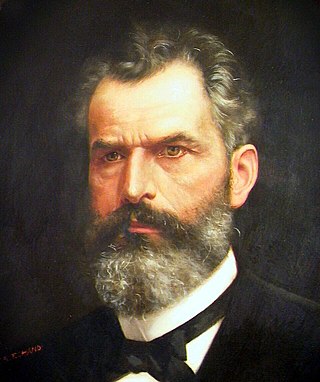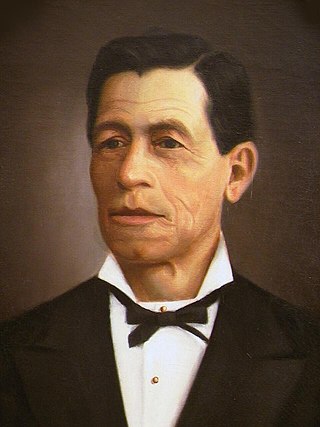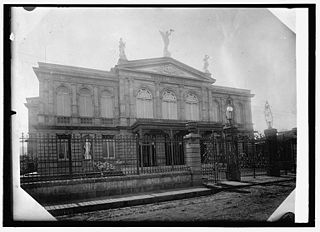
José Joaquín Rodríguez Zeledón was President of Costa Rica from 1890 to 1894.

Vicente de las Mercedes Herrera Zeledón was President of Costa Rica from 30 July 1876 to 11 September 1877. He came to power in the coup d'état that deposed President Aniceto Esquivel and resigned in favor of Gen. Tomás Guardia the following year.

A referendum on the Dominican Republic–Central America Free Trade Agreement (CAFTA) was held in Costa Rica on 7 October 2007. It was originally to be held on 23 September 2007, but it was postponed on 5 June 2007 due to a court challenge. Opinion polls from April, July and August 2007 suggested that a majority of voters were in favour, while a poll from June saw a majority against. It was ultimately approved by 51.56% of voters.
The name Constitutional was used for several loosely connected Costa Rican parties throughout history.

General elections were held in Costa Rica on 7 December 1919. Julio Acosta García of the Constitutional Party won the presidential election, whilst the party also won the parliamentary election, in which they received 74.9% of the vote. Voter turnout was 57.8% in the presidential election and 42.1% in the parliamentary election.
Head of State elections were held in Costa Rica on 11 April 1847, shortly after a coup d'état that overthrew the first head of state elected in direct elections; Francisco María Oreamuno Bonilla who was formally overthrown although he had previously left office without resigning. The de facto president was José María Alfaro Zamora who was a candidate but was defeated by José María Castro Madriz.
General elections were held in Costa Rica on 2 April 1876. Aniceto Esquivel Sáenz was elected president unanimously thanks to the influence of the acting president Tomás Guardia Gutiérrez who practically hand picked him. At that time and according to the Constitution, there were two electoral rounds; first all citizens legally allowed to vote chose electors and then the voters voted for the president.
General elections were held in Costa Rica on 9 July 1882. They were the first after a long line of successive de facto governments following the coup against Aniceto Esquivel Sáenz by his former ally Tomás Guardia Gutiérrez. Vicente Herrera Zeledón, Costa Rica's first conservative president, was placed in Esquivel's place, but in practice he was a puppet of Guardia's authoritarian regime. After the brief presidency of Herrera who resigned using health reasons as excuse, the political elite appoints Guardia to replace him. However Guardia died in 1882 and elections were called, which were won by Freemason and liberal Próspero Fernández Oreamuno member of the Olympus Generation, an elite group of liberal intellectuals nicknamed as such due to their arrogance.
General elections were held in Costa Rica on 4 April 1886. After the death of Próspero Fernández Oreamuno in March 1885, Bernardo Soto Alfaro took over the presidency temporarily for the remainder of the term. Soto was a thirty-year-old young man who had to command the country in the war against Guatemala that sought to re-establish the Federal Republic of Central America. Soto was a freemason and liberal, belonging to "The Olympus", a group of liberal intellectuals who would have a great influence on Costa Rican politics and many would hold the Presidency of the Republic.
General elections were held in Costa Rica in 1894. Voters elected members of the electoral college on 4, 5 and 6 February, who in turn elected the president on 1 April.
The 1901–1902 Costa Rican general election occurred under growing political tensions. The authoritarian government of Rafael Yglesias was in direct confrontation with the opposition and had re-elected himself as single-candidate in the previous election by a questionable constitutional reform. The liberal Republican Party represented the most staunch opposition and the country was on the edge of civil war. However, Yglesias managed to negotiate with the moderate branch of the Republicans for a peaceful power exchange.

The 1906 Costa Rican general election was held during the presidency of Ascensión Esquivel Ibarra. Ibarra openly supported candidate Cleto González Víquez. Other candidates were former president Bernardo Soto Alfaro, former State and Police Secretary Tobías Zúñiga Castro, the also former State Secretary Máximo Fernández Alvarado and former justice and Foreign Secretary Ezequiel Gutiérrez Iglesias. Difference were more personal than ideological as all candidates except Gutiérrez were liberals, and the election had a strong "anti-cletista" component. This "anti-cletismo" was what united the opposition and talks about a common joint front occurred but it was not applied. Gutiérrez was candidate of the conservative "Democratic Union", the party that emerged from the now outlawed Catholic Union.
The 1910 Costa Rican general election was held during the presidency of Cleto González Víquez. This was the last time that indirect elections were held in Costa Rica as for the next one in 1913 the direct vote was implemented. Liberal lawyer Ricardo Jiménez Oreamuno was elected for the first time. Jiménez was very popular in part because of his struggles against the United Fruit Company's abusive operations in the country. Jiménez was proclaimed candidate in the Teatro Variedades during the first Republican National Convention, Costa Rica's first primary election. Jiménez won easily over the other candidate, former president Rafael Yglesias who ruled an authoritarian, though short-lived, regime.

The First Costa Rican Republic is the name given to the historical period between the proclamation of the Republic of Costa Rica in the 1848 reformed Constitution and the official decree by then President José María Castro Madriz on 31 August 1848 and the Costa Rican Civil War of 1948 which ended with the enactment of the current 1949 Constitution on 7 November 1949 starting the Second Costa Rican Republic.
The Progressive Liberal Party was a Costa Rican political party that participated in the 1889 presidential election. Alongside the other newly formed party, the Democratic Constitutional Party (conservative), was one of the first political parties in the history of Costa Rica and the first in participating in a presidential election.

Liberalism in Costa Rica is a political philosophy with a long and complex history. Liberals were the hegemonic political group for most of Costa Rica's history especially during the periods of the Free State and the First Republic, however, as the liberal model exhausted itself and new more left-wing reformist movements clashed during the Costa Rican Civil War liberalism was relegated to a secondary role after the Second Costa Rican Republic with the development of Costa Rica's Welfare State and its two-party system controlled by social-democratic and Christian democratic parties.

The Olympus Generation, also called the 900 Generation, is the name given in Costa Rica to a group of intellectuals, teachers, historians, politicians and writers of liberal and positivist thought, whose ideas and philosophical, political, academic and cultural contributions were reflected in the sciences, arts, literature and politics between 1890 and 1920, this was the historical stage of Costa Rica where the liberal state is consolidated. Traditionally, they're known as the Olympus generation in reference to the Olympian gods of classical mythology, because most of them belonged to an oligarchic elite with political and economic power obtained from the international coffee trade during the second half of the 19th century. This was the nickname given by their detractors due to the arrogance of many of its members. The Olimpo generation played a leading role in the gestation of culture, national identity and the consolidation of the Costa Rican State.

The Liberal State is the historical period in Costa Rica that occurred approximately between 1870 and 1940. It responded to the hegemonic dominion in the political, ideological and economic aspects of liberal philosophy. It is considered a period of transcendental importance in Costa Rican history, as it's when the consolidation of the National State and its institutions finally takes place.

Freemasonry begins in Costa Rica at the same time as in Central America during the course of the 19th century. Regular masonry begins when it was founded by Costa Rican Catholic priest Francisco Calvo, ex-Chaplain General of the Army of Costa Rica during the Filibuster War of 1856, who introduced regular masonry in Central America in 1865. However, there is evidence of the existence of "non-regular" Lodges active after the Independence and before. Prominent Costa Rican figures of politics, literature, art and science, including several presidents of the Republic, were Freemasons.

Sara Casal de Quirós was a Costa Rican teacher, writer and community worker. She was a pioneer of the women's rights movement in Costa Rica and wrote the first book defending women's rights in the country.









